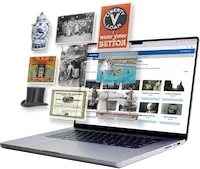Blending Data and Narratives to Demonstrate Archival Impact

Margot Note
There’s no doubt that archivists play a pivotal role in preserving our collective histories and cultural heritages. However, their challenge lies in safeguarding documents while demonstrating their work’s tangible and intangible impact.
Archivists can learn to measure and showcase their contributions using various methodologies, metrics, and narratives. Let’s take a look at how archivists can combine the power of data and narratives to strengthen the impact of their work.
Grounding Advocacy in Data
An archivist’s advocacy efforts are best anchored in robust data. Archivists should move beyond traditional metrics, like collection numbers and processing efficiency, to focus instead on data that speaks to the archival value proposition. Doing so requires considering the broader economic impact, audiences served, and outcomes achieved. To make compelling arguments, archivists must reference slices of data, providing a solid foundation for their stories.
Metrics that Matter
Quantifiable metrics offer a concrete way to measure the impact of archival work. Increased usage, reduced retrieval times, and improved preservation techniques are tangible indicators of success. These metrics demonstrate the efficiency of archival processes and showcase archives’ value to the organization. By presenting these metrics, archivists can highlight their efforts’ direct and measurable benefits.
Additionally, these quantifiable metrics play a crucial role in enhancing the accountability and transparency of archival institutions. They serve as a valuable tool for archivists to communicate the outcomes of their work to stakeholders and funding bodies. The ability to showcase specific numbers and improvements in usage, retrieval times, and preservation techniques not only underscores the efficacy of archival processes but also aids in making a compelling case for continued support and investment.
Furthermore, these metrics contribute to the ongoing refinement of archival practices, allowing institutions to adapt and evolve based on the demonstrated impact on users and the broader community. Integrating quantifiable metrics into archival assessments strengthens the field by providing a solid foundation for decision-making and strategic planning.
Shaping Decision-Making
While quantifiable metrics are crucial, archivists should also recognize the broader influence of archives on organizational culture and decision-making processes. Intangible impact encompasses the subtle yet powerful ways archives shape perceptions, influence decisions, and engage stakeholders. By acknowledging the dual nature of impact, archivists can present a comprehensive picture of their contributions beyond the numbers.
Additionally, archivists must embrace technology’s evolving role in archival practices. The digital age has brought unprecedented challenges and opportunities, requiring archivists to navigate the complexities of born-digital records, electronic archives, and preservation in a rapidly changing technological landscape.
As custodians of information, archivists must adapt to these advancements and explore innovative approaches to ensure the accessibility and longevity of digital archives. Embracing technology as an integral part of archival work enhances the profession’s ability to meet the dynamic needs of the contemporary information environment, further solidifying the significance of archives in preserving our cultural heritage and facilitating informed decision-making.
Ensuring Support for Organizational Goals
Concrete evidence of impact ensures ongoing administrative support. Archivists must assess aspects of their work that align with the institution’s overarching goals. Doing so requires a strategic approach to data gathering, using tools that analyze evidence for research and decision-making processes. There is a critical link between archival impact and institutional objectives.
To gather evidence, archivists employ data-gathering tools beyond quantitative metrics. These tools provide insights into the impact of archival services. Surveys, interviews, and focus groups offer qualitative evidence that complements quantitative data. User testimonials, particularly, become powerful narratives highlighting how archival resources enrich research, inform projects, and enable understanding. This multifaceted approach helps archivists uncover patterns and insights, strengthening the evidentiary basis for informed actions.
The Archival Narrative
Archivists must safeguard historical records and communicate the value of their work effectively. By combining tangible and intangible impact metrics, archivists can strengthen their narrative. Whether through reduced retrieval times or testimonials showcasing the profound impact on organizational knowledge, archivists have a wealth of data to tell compelling stories.
Archivists are storytellers of our shared past. Archivists measure their impact through methodologies that blend quantitative metrics with qualitative narratives. By grounding advocacy in data, showcasing tangible and intangible impacts, and ensuring alignment with institutional goals, archivists can elevate their contributions and secure the support needed to preserve cultural legacy.

Margot Note
Please join us for a free webinar, Measuring Archival Impact, on Wednesday, November 13, 2024 at 11 a.m. Pacific / 2 p.m. Eastern. (Can’t make it? Register anyway and we will send you a link to the recording afterwards). Register now to save your spot!
Never miss another post. Subscribe today!
Similar Posts
Principles of Archival Preservation: Agents of Deterioration and Preservation Strategies
Explore the 5 key agents of deterioration and essential archival preservation strategies to safeguard your collections for future generations.
Creating Effective Archival Finding Aids: Tips for Writing Clear Descriptions
Clear concise archival descriptions improve accessibility support discoverability and enhance the research experience. In this article we’ll explore best practices for crafting finding aids that are both informative and engaging.
Balancing Collection- and
Item-Level Information in Archival Description
How much detail is enough when describing an archival collection? Finding the right balance between broad overviews and detailed item descriptions ensures accessibility research efficiency and proper context for archival materials.
Best Practices in Archival Description
Standards like ISAD(G) DACS and EAD guide archivists in creating clear consistent descriptions for easier access. Learn more about each of these frameworks and how they enhance visibility and research.







Leave a Comment
Comments are reviewed and must adhere to our comments policy.
0 Comments